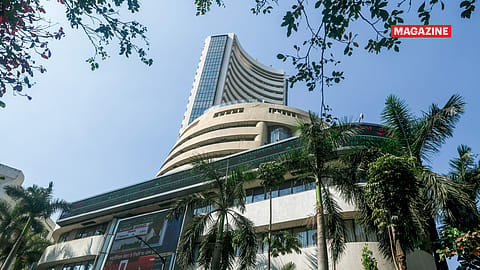Why the GST Reforms Haven’t Lit up the Markets
The U.S. President’s tariff salvo and record FPI outflows may have weighed down the impact of the central government’s ‘pre-Diwali’ gift on the markets.

This story belongs to the Fortune India Magazine global-brands-indian-sheen issue.
IN HIS INDEPENDENCE DAY address from the ramparts of the Red Fort on August 15, Prime Minister Narendra Modi announced what he called a “pre-Diwali” gift: next-gen GST reforms for simplifying the indirect tax structure to boost consumption and ease compliance.
On September 3, the GST Council’s 56th meeting set in motion “GST 2.0”. One of the major announcements was switching from the current four-tier tax structure (of 5%, 12%, 18% and 28%) to two slabs of 5% and 18%, with the special 40% rate retained for luxury and sin goods such as high-end cars, tobacco, and cigarettes. As a result, prices of essential and personal-use items, including hair oil, cornflakes, televisions, and health and life insurance premiums, have seen a significant reduction.
Despite the GST cheer, the reforms have failed to fire up D-Street, partly because the cut was largely anticipated. But more importantly, prevailing concerns over Q2 earnings and revenue growth, despite a robust Q1FY26 performance, have played spoilsport. For instance, after a dismal 1% earnings growth in FY25, the Nifty50 companies fared with a 15% year-on-year earnings growth in Q1, showcasing resilience amid global headwinds. Yet, earnings downgrades continue to overshadow growth.
Though the intensity of cuts in earnings per share (EPS) has eased to the lowest in the past four quarters, downgrades persisted in Q1, with profit estimates of the Top 200 firms for FY26 cut by 0.5% since June-end; the projected growth now stands at 12.1% (as of September 5).
An initial pop of less than 1% in the indices followed the PM’s Independence Day announcement. But the muted celebration turned sour, after U.S. President Donald Trump’s 25% punitive tariffs on India for doing business with Russia came into force on August 27. Trump followed it up with an unprecedented fee hike on H-1B visas and tariffs on pharma companies. Unsurprisingly, the markets have not made any gains since the beginning of September.
Meanwhile, foreign portfolio investors (FPIs) have pulled out a record ₹1.58 lakh crore year-to-date (as of October 3). “India’s strength remains in being a domestic-oriented economy, but in equities, this impact will last for a day or two. After that, the new sentiment, which could be external or internal, gets factored in,” says Madan Sabnavis, chief economist, Bank of Baroda.
The visa hike has resulted in a 5.37% decline of the IT sectoral index. The cumulative market cap erosion of IT heavyweights topped more than ₹2 lakh crore as tech majors Infosys and TCS led the fall. A stronger dollar and stretched valuations, combined with an overall weakened Q1 performance, fuelled caution among foreign investors. This explains the record-high FPI outflow.
More Stories from this Issue
The 100% U.S. tariffs on branded or patented drugs pushed down the Nifty Pharma index by nearly 5% in five sessions. The Sensex and the Nifty50 shed 2,097 and 632 points, respectively, during the same period.
The silver lining?
Yet, experts remain optimistic. “Even the H-1B visa, which should affect only one sector, somehow changes sentiment across others. Indian equities are not driven by fundamentals daily; however, on a long-term basis, if you look over a year, the market would have gone up if overall economic conditions were positive,” says Sabnavis.
A recent report by HSBC Global Investment Research said India’s markets are back on the front foot. “In cricketing terms, we expect it to return to form,” the report stated. It also highlighted that as valuations have fallen and the regional premium is back at historical levels, lower inflation and easing measures should support growth.
Aided by a likely improvement in the macro environment owing to the stimulative fiscal and monetary measures, EPS growth of the Nifty50 is projected to rise to around 9% in FY26 (vs an anaemic 1% in FY25), said a Motilal Oswal Financial Services report.
Despite a weak dollar and the resumption of rate cuts by the U.S. Federal Reserve, money is yet to flow back into emerging markets. And, India stands to be an outsized beneficiary should this happen. According to the Elara Global Liquidity Tracker, Indian equities saw $2.3 billion in outflows since July 2025, as global emerging market funds have cut their allocation to the country to 16.7%, the lowest in 22 months. However, this also suggests significant headroom for reallocation once sentiment improves.
At the same time, the India-U.S. trade talks are still underway. A positive outcome would trigger inflows from investors sitting on the sidelines. But for now, market watchers are observing if the GST cuts will fire up consumption in the coming quarters.